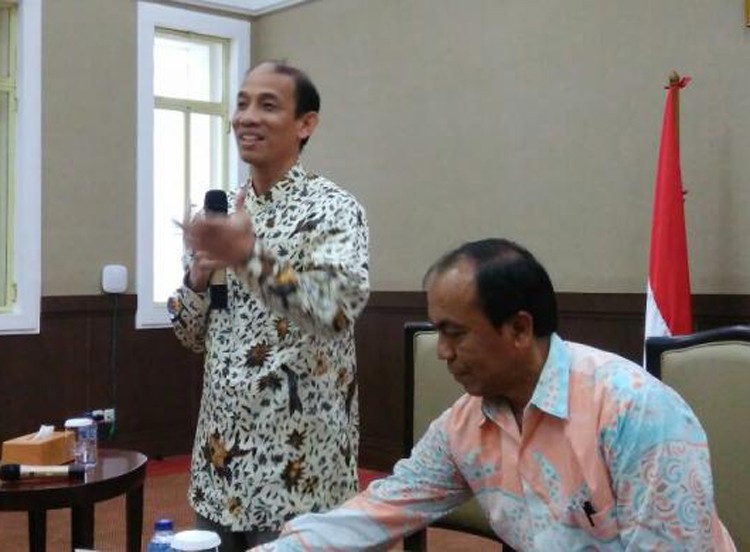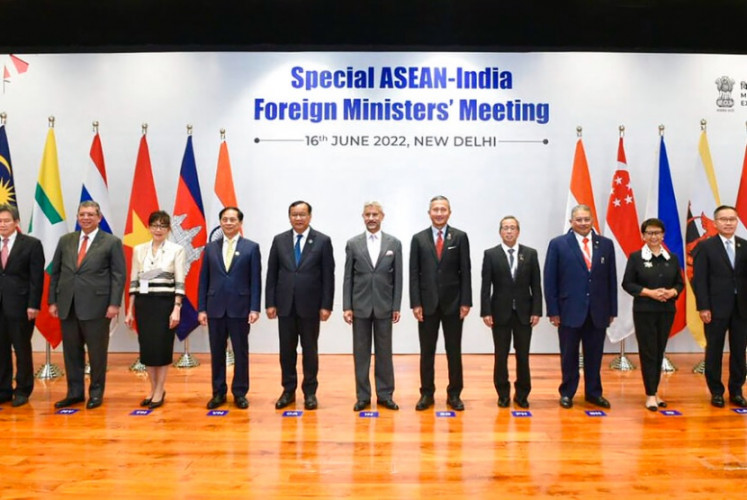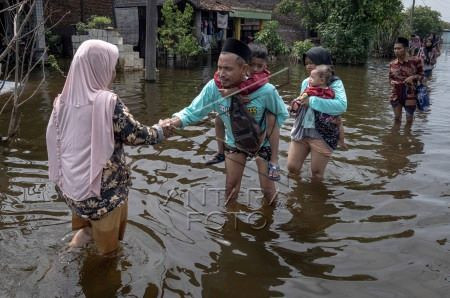Challenges for new energy and mineral resources chief
One of the new ministers appointed in the latest Cabinet reshuffle announced on July 27 is Arcandra Tahar, 45, who replaced Sudirman Said as energy and mineral resources minister. Looking at their educational backgrounds, the previous and current ministers would have different views on improving the management of Indonesia’s oil and gas activities.
This is certainly not surprising, as the previous minister is an accountant while his successor is a professional petroleum engineer and definitely has more knowledge on petroleum operations (onshore and offshore), etc.
Change Size
 Energy and Mineral Resources Minister Arcandra Tahar speaks to journalists in his office in Jakarta. (kompas.com/Estu Suryowati )
Energy and Mineral Resources Minister Arcandra Tahar speaks to journalists in his office in Jakarta. (kompas.com/Estu Suryowati )
O
ne of the new ministers appointed in the latest Cabinet reshuffle announced on July 27 is Arcandra Tahar, 45, who replaced Sudirman Said as energy and mineral resources minister. Looking at their educational backgrounds, the previous and current ministers would have different views on improving the management of Indonesia’s oil and gas activities.
This is certainly not surprising, as the previous minister is an accountant while his successor is a professional petroleum engineer and definitely has more knowledge on petroleum operations (onshore and offshore), etc.
Arcandra lived in the US for the last 20-years and his connection with Indonesia was mostly as a technical consultant. The energy minister portfolio on the other hand is a political position and how he will handle the political side of his job remains to be seen.
Unlike his predecessor, who emphasized better management of the oil and gas sector, Arcandra underlines the importance of technology in the search for oil and gas to increase production and reserves. He looks up to the US, which nearly doubled its oil and gas reserves within seven years. He also emphasizes the improvement of business procedures, which should be efficient and transparent.
For oil companies operating in Indonesia such a new minister’s statement is not new. In fact, advanced technology has consistently been applied in Indonesia’s onshore and offshore operations in every area from exploration, drilling and completing wells to remedial operations, artificial lift, corrosion control and environmental protection.
In exploration, highly sophisticated seismic methods both in the recording of data in the field and data interpretation offices such as 3-D seismic have extensively been used and helped oil and gas companies in Indonesia to find reserves. Also, by better understanding the subsurface before drilling, the industry can reduce the number of dry holes that make risks more measurable and limit environmental impacts. Furthermore, 4-D seismic technology has also been used in Indonesia since 1992 to monitor the movement in steam in the steamflood project in the Duri Field. The target is to increase recoverable oil and energy conservation.
In drilling, which involves the controlled deviation of a hole, advance technology has also been used both onshore and offshore. The total depth of a well can range from a few to several thousand feet from the surface location of the drilling rig. Drilling can therefore occur beneath environmentally sensitive areas using surface locations far removed from that area.
Directional drilling helps target formations that may lie under land or water that are not readily accessible by conventional means. One step beyond directional drilling, the innovation allows for drilling horizontally (instead of the more common vertical drilling) from a kick-off point below the surface out to a predetermined target that may be more than 1,000 feet away.
Horizontal drilling also enhances oil and gas recovery over traditional methods. In some cases, one horizontal well can replace several vertical wells, minimizing surface activity.
In oil production, only a fraction of the original oil and gas in place — often less than a quarter — can be removed using traditional methods. New technologies for getting more oil and gas production from existing wells, such as injection technology, have also been used.
Enhanced oil recovery technology, or essentially “pushing” oil or gas through the formation with water, steam or carbon dioxide, can also increase recovery by making oil or gas easier to move out of the formation and into the well. Although these techniques are very costly in their initial stages, they ensure maximum production from existing wells.
The successful application of these advanced technologies has been supported by the government, which provided reasonable access to the necessary technology, including permission to import equipment and export data by appropriate analysts and technological service centers outside of Indonesia. The government has also provided oil and operators to obtain qualified technical expertise as required to both analyze the data and to train Indonesian personnel.
Nonetheless, despite the advanced technology, the national petroleum industry has not been growing in leaps and bounds. Technically, this is due to volume and variety of sediments in tertiary basins across the archipelago. While commercially, this is due to legal uncertainty, such as the issuance of new regulations in which some provisions contradict contact terms.
One of the first actions expected by the industry is resolving the issue of cost recovery, or revocation of Government Regulation No. 79/2010 on the recoverable operational costs and treatment of a contractor’s income tax.
The purpose of the regulation is to increase state revenue by maintaining tight control of reimbursable operational costs, as cost recovery is now included as a separate item in the state budget. Under the regulation, some operational costs are not recoverable.
These include costs associated with community development during the exploitation phase and training of expatriate personnel. The regulation also authorizes the finance minister to set the maximum salary for an expatriate.
From the government’s perspective, cost recovery represents the reimbursement by the government to a company for costs incurred during exploration, development and production under the production sharing contract (PSC) scheme.
However, this perception is entirely wrong when we look at the government’s view that the reimbursement of a contractor’s expenditures is considered an income, which is taxable at 44 percent.
Scrapping or replacing the regulation may not be easy, as its proponents would include the involvement of the new finance minister, Sri Mulyani Indrawati.
Indonesia’s oil and gas production can only be increased by aggressive exploration and application of advanced production technology to increase oil recovery at each field. This would require a large risk in capital, which is scarce and mobile and it will always be looking at the best place that offers a high return and improvement of the work environment for the oil and gas prpoducers.
All the PSCs’ complaints as conveyed by the Indonesian Petroleum Association (IPA) should be addressed seriously and attempts should be made to resolve the issues at the earliest opportunity. A new oil and gas law should be Archandra’s priority. Such a new law should address the work environment for PSCs in order to provide legal certainty for oil and gas investors for years to come.
In economic terms, tax consolidation should be seriously considered as an exploration incentive. It works well in the UK and there is no reason why it could not work in Indonesia to promote exploration to increase recoverable oil and gas reserves.
Finally, the government’s involvement in PSC affairs should be restricted to approval of work program and budget and plan of development. This was the practice in early days of production sharing and this arrangement needs to be restored. Present oil and gas production can only be increased by aggressive exploration and application of enhanced oil recovery technology to increase oil recovery at each field.
***
The writer is a director of an energy consulting company in Jakarta.
---------------
We are looking for information, opinions, and in-depth analysis from experts or scholars in a variety of fields. We choose articles based on facts or opinions about general news, as well as quality analysis and commentary about Indonesia or international events. Send your piece to community@jakpost.com. For more information click here.









